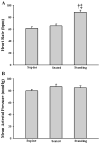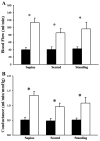Effects of posture on shear rates in human brachial and superficial femoral arteries
- PMID: 18245564
- PMCID: PMC3289057
- DOI: 10.1152/ajpheart.01108.2007
Effects of posture on shear rates in human brachial and superficial femoral arteries
Abstract
Shear rate is significantly lower in the superficial femoral compared with the brachial artery in the supine posture. The relative shear rates in these arteries of subjects in the upright posture (seated and/or standing) are unknown. The purpose of this investigation was to test the hypothesis that upright posture (seated and/or standing) would produce greater shear rates in the superficial femoral compared with the brachial artery. To test this hypothesis, Doppler ultrasound was used to measure mean blood velocity (MBV) and diameter in the brachial and superficial femoral arteries of 21 healthy subjects after being in the supine, seated, and standing postures for 10 min. MBV was significantly higher in the brachial compared with the superficial femoral artery during upright postures. Superficial femoral artery diameter was significantly larger than brachial artery diameter. However, posture had no significant effect on either brachial or superficial femoral artery diameter. The calculated shear rate was significantly greater in the brachial (73 +/- 5, 91 +/- 11, and 97 +/- 13 s(-1)) compared with the superficial femoral (53 +/- 4, 39 +/- 77, and 44 +/- 5 s(-1)) artery in the supine, seated, and standing postures, respectively. Contrary to our hypothesis, our current findings indicate that mean shear rate is lower in the superficial femoral compared with the brachial artery in the supine, seated, and standing postures. These findings of lower shear rates in the superficial femoral artery may be one mechanism for the higher propensity for atherosclerosis in the arteries of the leg than of the arm.
Figures




Similar articles
-
Vasoconstrictor responses in the upper and lower limbs to increases in transmural pressure.J Appl Physiol (1985). 2009 Jan;106(1):302-10. doi: 10.1152/japplphysiol.90449.2008. Epub 2008 Nov 13. J Appl Physiol (1985). 2009. PMID: 19008493 Free PMC article.
-
Impact of retrograde shear rate on brachial and superficial femoral artery flow-mediated dilation in older subjects.Atherosclerosis. 2015 Jul;241(1):199-204. doi: 10.1016/j.atherosclerosis.2015.04.017. Epub 2015 Apr 18. Atherosclerosis. 2015. PMID: 25917080
-
Measurement of arterial occlusion pressure using straight and curved blood flow restriction cuffs.Physiol Rep. 2024 Jun;12(12):e16119. doi: 10.14814/phy2.16119. Physiol Rep. 2024. PMID: 38898580 Free PMC article.
-
Impact of age and body position on the contribution of nitric oxide to femoral artery shear rate: implications for atherosclerosis.Hypertension. 2014 May;63(5):1019-25. doi: 10.1161/HYPERTENSIONAHA.113.02854. Epub 2014 Feb 17. Hypertension. 2014. PMID: 24535011 Free PMC article.
-
Retrograde arterial leg blood flow during tilt-back from a head-up posture: importance of capacitive flows when arterial pressure changes.J Appl Physiol (1985). 2010 Mar;108(3):533-7. doi: 10.1152/japplphysiol.01184.2009. Epub 2010 Jan 7. J Appl Physiol (1985). 2010. PMID: 20056847
Cited by
-
Brachial artery flow-mediated dilation following exercise with augmented oscillatory and retrograde shear rate.Cardiovasc Ultrasound. 2012 Aug 11;10:34. doi: 10.1186/1476-7120-10-34. Cardiovasc Ultrasound. 2012. PMID: 22883166 Free PMC article. Clinical Trial.
-
Evaluation of forearm vascular resistance during orthostatic stress: Velocity is proportional to flow and size doesn't matter.PLoS One. 2019 Nov 15;14(11):e0224872. doi: 10.1371/journal.pone.0224872. eCollection 2019. PLoS One. 2019. PMID: 31730662 Free PMC article.
-
Effect of aging on mechanical stresses, deformations, and hemodynamics in human femoropopliteal artery due to limb flexion.Biomech Model Mechanobiol. 2018 Feb;17(1):181-189. doi: 10.1007/s10237-017-0953-z. Epub 2017 Aug 16. Biomech Model Mechanobiol. 2018. PMID: 28815378 Free PMC article.
-
Exercise-induced Signals for Vascular Endothelial Adaptations: Implications for Cardiovascular Disease.Curr Cardiovasc Risk Rep. 2012 Aug 1;6(4):331-346. doi: 10.1007/s12170-012-0241-5. Curr Cardiovasc Risk Rep. 2012. PMID: 22844545 Free PMC article.
-
Relationship between upper and lower limb conduit artery vasodilator function in humans.J Appl Physiol (1985). 2011 Jul;111(1):244-50. doi: 10.1152/japplphysiol.00290.2011. Epub 2011 Apr 21. J Appl Physiol (1985). 2011. PMID: 21512151 Free PMC article.
References
-
- Baron BW, Glagov S, Giddens DP, Zarins CK. Effect of coarctation on matrix content of experimental aortic atherosclerosis: relation to location, plaque size and blood pressure. Atherosclerosis. 1993;102:37–49. - PubMed
-
- Blair JM, Glagov S, Zarins CK. Mechanisms of superficial femoral artery adductor canal stenosis. Surg Forum. 1990;41:359–360.
-
- Bleeker MW, De Groot PC, Rongen GA, Rittweger J, Felsenberg D, Smits P, Hopman MT. Vascular adaptation to deconditioning and the effect of an exercise countermeasure: results of the Berlin Bed Rest study. J Appl Physiol. 2005;99:1293–1300. - PubMed
-
- Chappell DC, Varner SE, Nerem RM, Medford RM, Alexander RW. Oscillatory shear stress stimulates adhesion molecule expression in cultured human endothelium. Circ Res. 1998;82:532–539. - PubMed
Publication types
MeSH terms
Grants and funding
LinkOut - more resources
Full Text Sources
Medical

